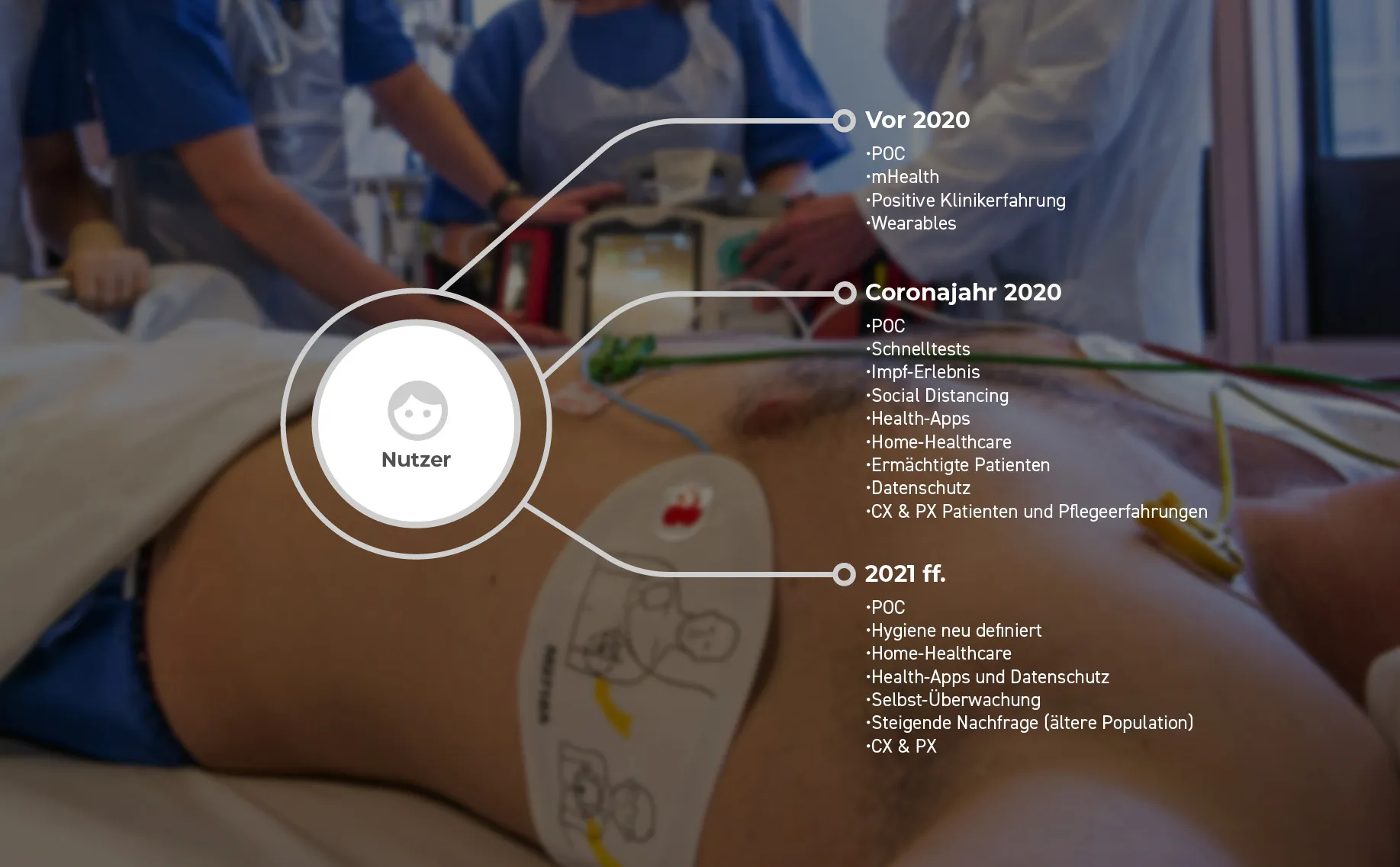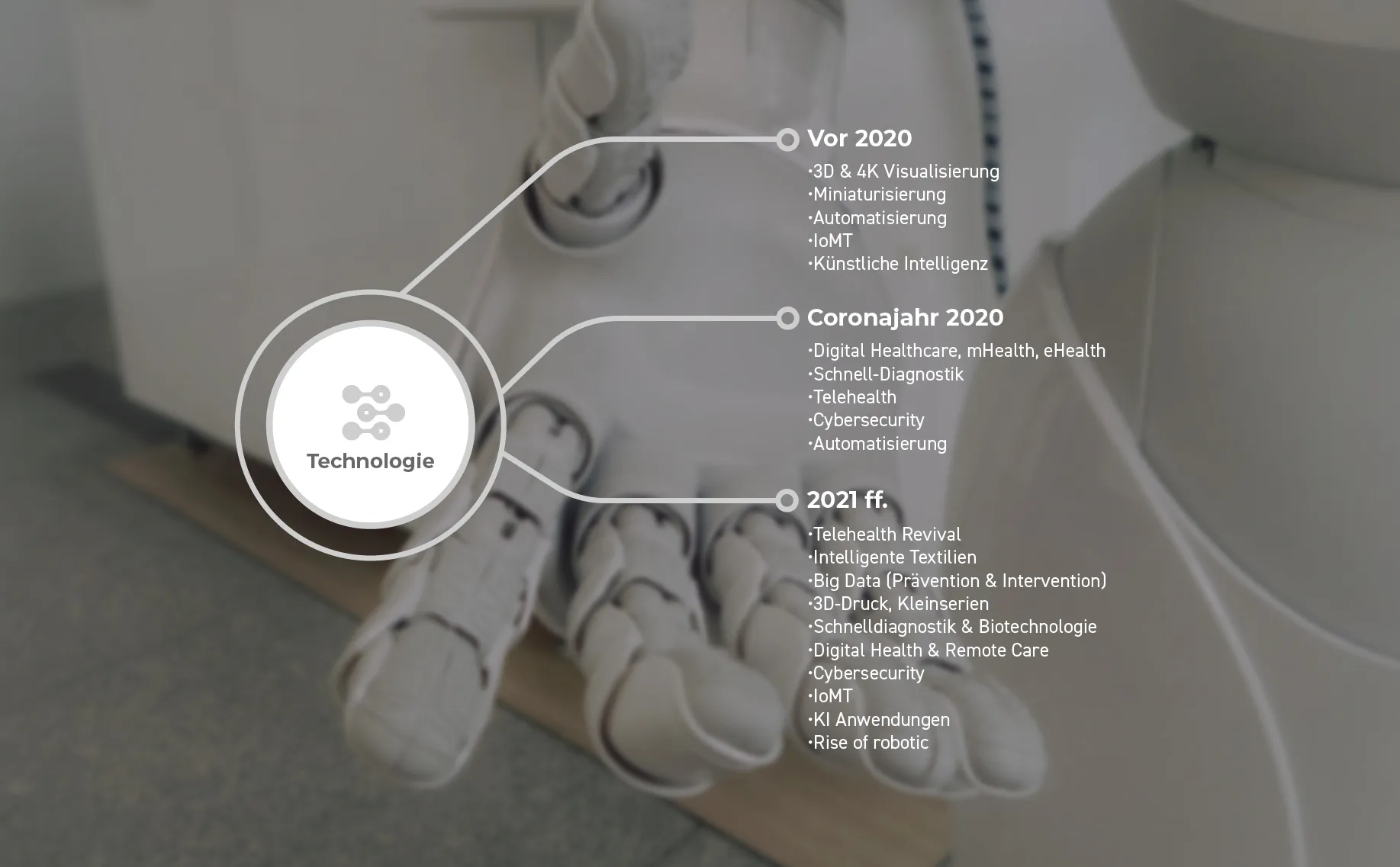Expertise
Current trends in medical design - update after Corona
It's time again for an update of the Medical Design Trends, originally collected and published in 2018! Developments in the healthcare industry are exciting and worth keeping an eye on. Long-term trends have been apparent for years, which we have also observed and summarized in our previous updates. Technological solutions in particular are changing entire processes and responsibilities in institutions. The coronavirus pandemic is accelerating this to some extent and is also adding new trends. (Read the 94 trend forecasts that Markus Wild wrote down at the beginning of the pandemic ) In this article, we have summarized the relevant trends in four areas: Users, Design, Technology and Clinical/Medical. Detailed sources can be found at the end of the article.
1. USER
The population as a whole is getting older, so the need for medical equipment and support is increasing. At the same time, however, postponable procedures and treatments in clinics and surgeries were canceled at the beginning of the pandemic and we are currently experiencing this again. Home healthcare is therefore becoming increasingly popular. The independent use of devices at the point of care empowers patients and increases their familiarity with their own illness and how to deal with it. At the same time, the need for user-friendly devices is increasing.
Solutions for point-of-care (POC) and wearables include, for example, badges for care staff that record hand hygiene; in-ear wearables that measure vital signs and provide voice prompts for exercise programs; and many more. The trend towards self-monitoring is also on the rise in 2021: increased self-testing gives users more flexibility.
The focus is therefore increasingly on users and patients. Their needs can be tracked on a patient journey - analogous to the customer journey. In addition to physical and virtual patient experiences (PX: patient experience), the experiences of nurses (CX: caregiver experience) are also coming to the fore. You can find an exemplary solution to support the work of nursing staff in one of our case studies.

2. DESIGN
Panel PCs and touchscreens play an important role for the PX, as they are increasingly acting as mediators. This increases the need for UX, UI and spatial design in order to create the best possible patient experience. Technology and comfort aspects must be taken into account when designing. A hospital stay can also be made more comfortable with digital solutions.
In line with the areas of home healthcare, usability and PX, devices are becoming increasingly customized and mobile. Wearables must be made to fit the body perfectly to ensure comfort. But comfort is not the only focus. The example of tests and masks in the fight against the pandemic makes it clear that they are helpful, but not environmentally friendly. Beyond everyday helpers, the development of biodegradable or reusable parts is needed to reduce medical waste. To identify needs like these, we focus on design thinking. By focusing on people, problems can be identified and solutions found.
However, these solutions do not look the same all over the world. Regulatory changes such as the MDR and IVDR are affecting investment in Europe this year. China, on the other hand, continues to emerge as a growing nation: domestic investment is boosting success. Since the SARS-CoV-2 pandemic, there has been an increase in M&As and collaborations between companies.
At the same time, international laws are different and influence the safety and quality standards of products. Originality is also a factor that is very important for designers globally, as globalization and digitalization mean that designs can be disseminated quickly. The boundaries between copies and the orientation towards the tried and tested are not always clear.

3. TECHNOLOGY
The healthcare industry is becoming increasingly digital: the Internet of Medical Things (IoMT), apps and artificial intelligence (AI) are providing intelligent, digital and virtual solutions. These can contribute to the early detection of epidemics or the development of new medicines, for example. With all its benefits, the digital healthcare sector is getting bigger and bigger: mHealth, eHealth and telemedicine are on the rise.
This increasing connectivity requires additional hardware and software systems. For example, smartwatches are being transformed into medical devices: non-invasive measurements are carried out with the help of biosensors, providing real-time data. The health functions then provide information about heart function, among other things. The result of many of these digital applications is called big data. This area offers many opportunities for prevention and intervention. Big data can also contribute to optimal staffing and process optimization.
This is precisely where the versatile field of robotics comes in. On the one hand, robots can appear human: In this case, they take on social activities or serve as receptionists. In many other areas, the helpers can speed up processes and take on work that care staff can then spend elsewhere. For example, robots can disinfect equipment, carry out (medical) deliveries within the institution or take blood samples.
They can also lend a hand when lifting patients, thus reducing the strain on staff. Specialized robots also provide considerable improvements: As prostheses, they enable simultaneous, complex movements through electromyography. Interactive microimplants serve as interfaces for human-technology interaction and the adaptation of treatments. Using nanotechnology, the implants can be used to treat specific structures in the body.
Extended reality, 3D and 4K visualizations ensure an appealing and user-friendly presentation of digital content. Formats can, for example, provide extended treatments for psychotherapy, such as cognitive stimuli for dementia patients. Virtual reality can also be used to simulate operations.

4. CLINIC/MEDICINE
The increasing focus on patient needs is also becoming apparent in this category: personalized medicine and genomic medicine enable a new form of prevention. This holds many opportunities for oncology in particular. AI is also enabling personalized treatments in plastic and aesthetic surgery. For example, facial recognition can be used to visualize the results of an operation in advance or suggest skin care products to patients that meet their needs.
Clinics have been using minimally invasive procedures for years. You can read more about this in our three blog posts "The future is non-invasive". The aim is to promote healing with the smallest possible interventions. Patients regenerate faster and suffer less stress. New technologies are also helping to improve bottlenecks in clinics. Specialized clinics contribute to maximum quality treatment, as (digital) POC solutions allow hospitals to focus on specific diseases. In future, simpler diagnostics can also be performed elsewhere: With the need to be treated directly at the point of care, the importance of pharmacy is also changing.
2020/21 was dominated by vaccine development, vaccination and diagnostic testing. All players in healthcare were suddenly given new and expanded tasks. What will remain of this? A large proportion of rapid tests can be carried out in pharmacies without placing an additional burden on doctors' surgeries. Pharmacies are therefore likely to become increasingly patient-oriented. Here, too, picking robots can take over logistical tasks - valuable time that staff can save and spend on providing advice. In addition to pharmacies, other institutions are also calling for a re-evaluation of supply chains. The goals: Reduce overall costs, centralized decision-making and optimizations for patients and staff. Drive-through clinics are also an interesting model for the future, which has already proven itself with Covid-19 tests.

Opportunities & risks
One risk that scientists see with the developments described is the substitution of humans in the world of work. However, this is countered by the assumption that humans will not be completely replaced but, on the contrary, will be able to concentrate better on their skills by having AI take over monotonous, practical and bureaucratic tasks. This results in many optimizations for clinics, patients and nursing staff. Machines do not have to replace people - but they can provide them with wonderful support. A few examples of this were mentioned in this article. In the medical field, AI and big data can be used to identify illnesses more quickly and coordinate optimal individual treatment for patients.
For all more complex activities, the intuitive "knowledge" of humans and their unbeatable ability to improvise when problems arise will always be required. In clearly defined areas, however, the machine - or rather the robot - will soon be an indispensable part of the care sector and operating theater and will surpass human performance in some areas. The robot will be a very helpful and everyday tool in the healthcare sector. No more - but also no less.
Sven Dörhage, Office Manager Munich
Problems associated with digital solutions are data protection and user privacy. Their data is valuable and it is important to protect this private, health-related data. This is why cybersecurity is becoming increasingly important.
How will the trends develop?
The trends summarized in this article have been emerging for some time. It is very likely that they will continue to develop and offer new opportunities. Of course, as development progresses, new risks also emerge that need to be kept in mind, just like the medical trends. In this way, we will always find new indications for progressive design.
Trends are also taken into account in our 24 design factors. You can read more about the factor here.
Author: Markus Wild, January 2023
04 Tips from the expert
- Focus on human-centered design
Align your products and services consistently with the needs of the user. Consider the patient experience (PX) and the caregiver experience (CX) to create user-friendly and effective solutions. - Consider sustainability and environmental friendliness
Develop products that reduce medical waste and use sustainable materials. Eco-friendly design is becoming increasingly important and strengthens the positive perception of your brand. - Usedesign and futurology as a strategic tool
Combine design with futurology to achieve powerful strategic advantages. This combination can drive innovation and future-proof your company. Ask us how it works! - Integrate trends into your development roadmap
Incorporate current trends and meta-trends into your development planning. This will ensure that your products meet future requirements and position themselves successfully on the market.
Frequently asked questions





